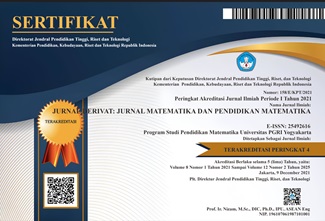An Optimization Model for the Nurse Scheduling Problem Considering Workload Variance
DOI:
https://doi.org/10.31316/j.derivat.v11i3.6899Abstract
The Nurse Scheduling Problem (NSP) is a critical issue in healthcare management, involving the assignment of nurses to shifts while adhering to constraints such as hospital requirements, legal obligations, and nurse preferences. A key objective is to balance workloads among nurses, minimizing variance to prevent burnout and ensure high-quality patient care. Despite various models addressing NSP, such as goal programming and stochastic methods, a significant gap remains in balancing workloads within individual shifts, which is crucial for nurse well-being and operational efficiency. This study develops an optimized nurse scheduling model for the emergency department (ED) of Dr. Saiful Anwar Hospital (RSSA) in Malang, using data from January 2024. The model considers 21 nurses, including 4 chief nurses, and aims to minimize workload variance across shifts while ensuring each nurse works at least 21 days per month. The simulation results show that the optimized schedule achieves a more equitable distribution of shifts and days off compared to the actual January 2024 schedule. The optimized model ensures that all nurses, except chief nurses, are assigned 21 working days with evenly distributed rest days, reducing fatigue and enhancing nurse well-being. This study advances NSP research by focusing on workload balance within shifts, contributing to improved healthcare service quality and nurse satisfaction. Future research should explore adaptive scheduling and incorporate factors like nurse preferences and patient acuity to further enhance scheduling flexibility and efficiency.
Keywords: Nurse Scheduling Problem, Optimization, Scheduling
References
Rerkjirattikal, P., Huynh, N., Olapiriyakul, S., & Supnithi, T. (2019). A Goal Programming Approach to Nurse Scheduling with Individual Preference Satisfaction. Mathematical Problems in Engineering, 2020(1), 2379091. https://doi.org/10.1155/2020/2379091
Lee, K.Y., Zakaria, N., & Zakaria, N. (2024). Examining the Impact of Burnout on Hospital Nurses Engaged in Shift Work: Insights From a Nationwide Cross-Sectional Study in Malaysia. SAGE Open Nursing, Vo. 10: 1-11, DOI: 10.1177/23779608241245212
Dyrbye, L. N., Shanafelt, T. D., Johnson, P. O., Johnson, L. A., Satele, D., & West, C. P. (2019). A Cross-Sectional Study Exploring the Relationship between Burnout, Absenteeism, and Job Performance among American Nurses. BMC Nursing, 18, 57. https://doi.org/10.1186/s12912-019-0382-7
Labrague, L. J., De Los Santos, J. A. A., Falguera, C. C., Nwafor, C. E., Galabay, J. R., Rosales, R. A., & Firmo, C. N. (2020). Predictors of Nurses’ Turnover Intention at One and Five Years’ Time. International Nursing Review. 67(2), 191-198. https://doi.org/10.1111/inr.12581
Tawfik, D. S., Scheid, A., Profit, J., Shanafelt, T., Trockel, M., Adair, K. C., Sexton, J. B., & Ioannidis, J. P. A. (2019). Evidence Relating Health Care Provider Burnout and Quality of Care: A Systematic Review and Meta-analysis. Annals of Internal Medicine, 171(8), 555-567. https://doi.org/10.7326/m19-1152
Rehman, A. U., Usmani, Y. S., Mian, S. H., Abidi, M. H., & Alkhalefah, H. (2023). Simulation and Goal Programming Approach to Improve Public Hospital Emergency Department Resource Allocation. Systems, 11(9), 467. https://doi.org/10.3390/systems11090467
Schoenfelder, J., Bretthauer, K. M., Wright, P. D., & Coe, E. (2020). Nurse scheduling with quick-response methods: Improving hospital performance, nurse workload, and patient experience. European Journal of Operational Research, 283(1), 390-403. https://doi.org/10.1016/j.ejor.2019.10.047
Ramirez, I. M. P. (2024). Nurse Staff Scheduling Optimization Model in the Emergency Room of the Hospital Escuela Universitario. Proceedings of the 10th World Congress on Mechanical, Chemical, and Material Engineering (MCM’24). DOI: 10.11159/icmie24.135
Fitriani, S. N., Bambang Irawanto, Abdul Aziz (2020). Nurse Scheduling Problem using Fuzzy Goal Programming with MINMAX Approach. Journal of the Institute of Electronics and Computer, 2, 151-161. https://doi.org/10.33969/JIEC.2020.21010.
Hakim, L., Bakhtiar, T., Jaharuddin (2017). The Nurse Scheduling Problem: a Goal Programming and Nonlinear Optimization Approaches. IOP Conf. Se.: Mater. Sci. Eng. 166 012024. DOI: 10.1088/1757-899X/166/1/012024
Khalili, N. Shahnazari Shahrezaei, P., Abri, A. (2020). A Multi-objective Optimization Approach for a Nurse Scheduling Problem Considering the Fatigue Factor. Journal of Applied Research on Industrial Engineering 7(4), 396-423
Malekian, S., Komijan, A. R., Shoja, A., Ehsanifar, M. (2023). New Nurse Scheduling Problem Considering Burnout Factor and Undesirable Shifts under COVID-19 (A Real Case Study). Journal of Industrial and Systems Engineering Vo. 15, No. 1, pp. 280-305
Downloads
Published
Issue
Section
Citation Check
License
Copyright (c) 2025 Jamaliatul Badriyah

This work is licensed under a Creative Commons Attribution-ShareAlike 4.0 International License.
Authors who publish with this journal agree to the following terms:
-
Authors retain copyright and grant the journal right of first publication with the work simultaneously licensed under a Creative Commons Attribution-ShareAlike 4.0 International License that allows others to share the work with an acknowledgment of the work's authorship and initial publication in this journal.
- Authors are able to enter into separate, additional contractual arrangements for the non-exclusive distribution of the journal's published version of the work (e.g., post it to an institutional repository or publish it in a book), with an acknowledgment of its initial publication in this journal.
- Authors are permitted and encouraged to post their work online (e.g., in institutional repositories or on their website) prior to and during the submission process, as it can lead to productive exchanges, as well as earlier and greater citation of published work (See The Effect of Open Access).







